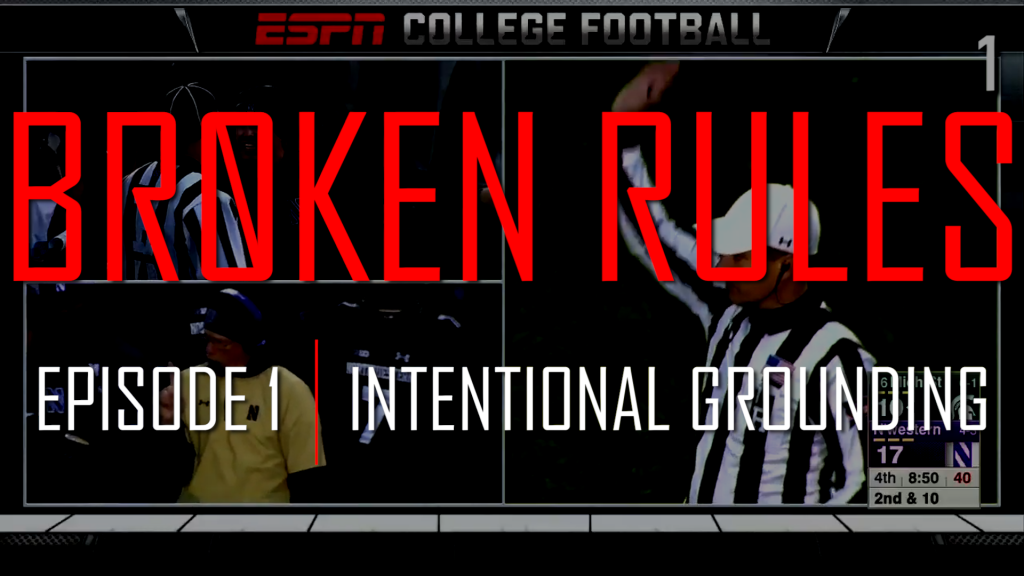I watched a LOT of football on Saturday. I was still slightly recovering from a weird cold / flu thing I had all day Friday, plus it was a nasty day in Chicago, so I had plenty of excuses to watch football all day. To be fair, I’m usually watching 2 TVs of college football every Saturday in the fall, anyways.
I’m usually a quiet observer of the games, venting any frustrations to Twitter and carrying on. There are some things that cause me to audibly voice my frustrations to no one in particular, hoping that someone will appear out of nowhere to confirm that I’m not crazy despite rambling to a television. The thing that caused me to go slightly insane on Saturday was the lack of intentional grounding calls.
I went slightly crazy during the Michigan-Indiana game a couple weeks ago where there were multiple no-calls on some iffy throws that probably should have been called. I reviewed one of them in my MGoFilm Analysis videos:
Take a couple no-calls in that game lingering in my mind, add in 5 more plays from 3 different games on Saturday, and you have me rambling nonsense like I’m Eleven’s mom from Stranger Things 2. (If you don’t get that reference, watch Stranger Things 2, it’s fantastic).
What about intentional grounding do I dislike, you ask? I have 3 main “pull my hair out” gripes:
- The “in the area” verbiage in the rule book.
- As long as a throw is “in the area” of an eligible receiver, it’s not a penalty. It’s up to anybody to determine what “in the area” actually means in terms of yardage. Ambiguity usually sucks; ambiguity in a rule book sucks a whole lot.
- Example: You could throw the ball 15 yards out of bounds to an area even Charles Woodson couldn’t bring down, but since there’s a WR meandering towards the sideline, it’s not a penalty.
- It doesn’t allow for judgement of the scenario from a referee.
- Scenario A: A QB throws the ball 20 yards beyond a WR who runs a hitch. There was no pressure, the QB threw the ball cleanly, expecting the receiver to be running a hitch-n-go.
- Scenario B: Brian Lewerke is scrambling, does a 360 degree spin, chucks it 10+ yards out of bounds with 4 seconds of hang-time to allow a receiver to run towards the sideline despite not being close to it on his route. Ball would never be catchable.
- Both of those situations are judged on the same criteria by the rules. Despite being very different situations, there is no room for judgement of the specific scenario from the referee. Scenario A didn’t happen on Saturday, but I’ve seen it enough times. With the current rules in place, scenario A would be a penalty, but scenario B was not on Saturday. That’s insanity and should not be the case.
- The rule book does not capture the spirit of the rule.
- This rule is in place to properly credit the defense when they make a good play. After all, a quarterback is usually only intentionally grounding the ball to nowhere in particular in order to save time, yardage, or both. In that scenario, the defense usually has good coverage downfield, applied effective pressure to the QB, or a combination of both.
- Given the leniency of the “in the area” verbiage and no way to allow officials to apply judgement to overrule the other criteria for the rules, QBs are allowed to intentionally ground the ball and only get called for it maybe 10% of the time that they’re actually meaning to intentionally ground it. This speaks to a lack of enforceable power with the current definition of the rule.
Anyways, here’s the video, where I cover 5 plays from 3 games I watched Saturday. I explain the rules, the tackle box, and propose some changes to the rule book that I’m positive will never change because the NCAA is the worst. Enjoy!
- Recruit Video Review: Ep. 11 – CB Darion Green-Warren - Jul 20, 2020
- Recruit Review: Ep. 10 – S Jordan Morant - Jul 14, 2020
- Recruit Review: Ep. 9 – DE Braiden McGregor - Jul 7, 2020

